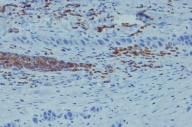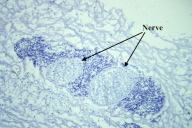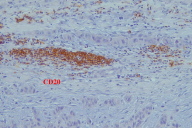Dense lymphocytic infiltrates associated with non-melanoma skin cancer in patients with chronic lymphocytic leukemia
Published Web Location
https://doi.org/10.5070/D333j4h764Main Content
Dense lymphocytic infiltrates associated with non-melanoma skin cancer in patients with chronic lymphocytic leukemia
Morgan L Wilson1, Dirk M Elston2, William B Tyler3, Victor J Marks1, Tammie Ferringer2
Dermatology Online Journal 16 (3): 4
1. Department of Dermatology2. Departments of Dermatology and Pathology
3. Department of Pathology
Geisinger Medical Center, Danville, Pennsylvania. mlwilson@geisinger.edu
Abstract
Chronic lymphocytic leukemia (CLL) is a common hematologic malignancy associated with an increased risk of non-melanoma skin cancer. Basal cell carcinomas and squamous cell carcinomas in these patients may have an associated dense peritumoral leukemic infiltrate. This infiltrate can lead to the diagnosis of CLL and may also obscure tumor margins and pose a challenge in the assessment of perineural tumor spread. Immunohistochemical stains are useful in distinguishing leukemic B-cell infiltrates from tumor-reactive T-cell infiltrates. Leukemic cells of CLL are CD20+/CD23+/CD5+/CD43+/CD3-, whereas benign reactive infiltrates are composed of CD20-/CD23-/CD5+/CD43+/CD3+ T-cells. Given the paucity of symptoms in early stages of CLL, a dense lymphoid infiltrate surrounding a cutaneous neoplasm may serve as the first indication of CLL. We report a series of three cases of SCC with a coexisting infiltrate of CLL, including one with perineural involvement, one involving metastatic SCC, and one in which this histologic finding spurred the initial diagnosis of CLL.
Introduction
Chronic lymphocytic leukemia (CLL) is the most common leukemia in adults in western nations [1]. Patients with CLL are reported to have an eight-fold increased risk of developing nonmelanoma skin cancer (NMSC) [2, 3]. Following Mohs surgical excision, CLL patients have a seven-fold and fourteen-fold increase in rate of recurrence of squamous cell carcinoma [4] and basal cell carcinoma [5], respectively.
Dense peritumoral lymphocytic infiltrates composed of leukemic B-cells have been described in CLL patients with squamous cell carcinoma (SCC) and basal cell carcinoma (BCC) [6, 7, 8]. Recognition of this phenomenon may lead to the diagnosis of CLL [6, 9, 10].
Such infiltrates are also of significance because they may obscure histological margins. We report three cases and discuss histological differentiation from a reactive lymphoid infiltrate. In one of our cases, the infiltrate was present in a perineural pattern. Because reactive perineural lymphoid infiltrates can be a marker for perineural tumor extension, failure to identify the infiltrate as leukemic may result in larger postoperative defects [8].
Clinical Synopses
Case 1
 |  |
| Figure 1A | Figure 1B |
|---|---|
| Figure 1. Hematoxylin-eosin (H&E) stained frozen sections show invasive SCC in association with a dense lymphocytic infiltrate. (Figure 1A. x20, Figure 1B. x400) | |
An 84-year-old man presented to Mohs surgery for treatment of a biopsy-confirmed, well-differentiated SCC in the left infra-auricular area. The final Mohs stage revealed a dense inflammatory infiltrate, raising concern of obscured, residual SCC within the infiltrate. Cytokeratin stains failed to reveal residual tumor, confirming adequate margins.
At follow-up, an SCC of the right superior helical rim was treated via the Mohs technique. Again, a significant peritumoral inflammatory response was noted on Mohs sections (Figure 1). Cervical and axillary lymphadenopathy were identified, which, according to the patient, had been present for years. Due to suspicion of a lymphoproliferative disorder, a CBC was obtained, revealing a WBC count of 54,400 with 89 percent lymphocytes. A tentative diagnosis of CLL was made, and consultation with the hematology service was recommended. However, the patient declined further evaluation or treatment.
Case 2
 |  |
| Figure 2A | Figure 2B |
|---|---|
| Figure 2A. Invasive SCC in association with a dense lymphocytic infiltrate (H&E, x200) Figure 2B. The lymphocytic infiltrate is CD20 positive (H&E, x200) | |
 |  |
| Figure 2C | Figure 2D |
|---|---|
| Figure 2C. The lymphocytic infiltrate is CD23 positive (x200) Figure 2D. The lymphocytic infiltrate is CD5 positive (x200) | |
A 77-year-old man with a 10-year history of CLL and multiple NMSCs presented to Mohs surgery for excision of a biopsy-proven SCC of the right scalp. During Mohs excision, a dense peritumoral inflammatory infiltrate and a similar infiltrate around a deep peripheral nerve were identified (Figures 2 and 3). Tissue was sent for immunohistochemical stains to differentiate perineural SCC-associated inflammation from a leukemic infiltrate. The infiltrating cells were noted to express CD20, CD23 and CD5, consistent with the patient’s known CLL (Figure 2). Cytokeratin stains failed to reveal perineural SCC (Figure 3).
Case 3
 |
| Figure 4C |
|---|
An SCC of the forehead was excised from a 76-year-old man. However, multiple cutaneous and nodal metastases developed two months later. Radiation therapy and chemotherapy were only partially helpful. Palliative excision of the metastatic nodules over the right temple was performed and microscopic examination showed moderately to poorly differentiated metastatic SCC with dense perivascular lymphoid aggregates (Figure 4A). The lymphoid cells were CD20 and CD5 positive (Figures 4B and 4C), but CD3 negative. The dermatopathologist, concerned about a cutaneous leukemic infiltrate, consulted the clinician, who confirmed a known history of CLL.
Discussion
Chronic lymphocytic leukemia accounts for 22-30 percent of all leukemias [11]. After excision with microscopically controlled margins, the rate of recurrence in patients with CLL is 7 times higher for SCC [12] and 14 times higher for BCC [5] than in similar patients without CLL. This increased occurrence and recurrence of cutaneous neoplasms in CLL patients is likely related to immune dysfunction, although recurrence may also result from positive margins obscured by the dense infiltrates.
Immune defects in CLL are numerous and include hypogammaglobulinemia, leukemic cell production of circulating IL-2 receptor with consequent removal of endogenous IL-2, down-regulation of CD40-ligand (CD154) on activated T-cells, defective expression of costimulatory antigens CD40 and CD80 on dendritic cells, decreased NK cell activity, decreased neutrophil function, and hypocomplementemia [13]. Treatment with chemotherapeutic agents in advanced chronic leukemia may further compromise immunity.
Given their increased incidence of skin cancer, patients with CLL frequently present to dermatologists and dermatologic surgeons for diagnosis and treatment. Evaluation of biopsy specimens from these patients may be complicated by the presence of dense, monomorphic lymphocytic infiltrates associated with the cutaneous neoplasms. Mehrany et al. [8] found dense lymphocytic infiltrates associated with SCC and BCC in 36 percent of patients with CLL, compared with 1 percent of controls.
The finding of such infiltrates can pose a significant difficulty for those interpreting the histological sections. Cutaneous malignancies are frequently associated with reactive inflammatory infiltrates; in patients with CLL, it may not be clear whether a lymphocytic infiltrate is part of the leukemic process or part of a reaction to residual carcinoma. During Mohs surgery, this has led to the resection of additional tissue and increased size of postoperative surgical defects [8]. This infiltrate may also obscure or simulate perineural tumor extension, requiring cytokeratin stains for clarification [14, 15], as demonstrated in case 2 above.
In the study by Mehrany et al. [8], 75 percent of the peritumoral dense lymphocytic infiltrates in patients with CLL were B-cell leukemic infiltrates. Differentiation of a leukemic infiltrate from a reactive inflammatory infiltrate is based on immunohistochemical characterization. The immune response to cutaneous malignancies in immunocompetent individuals is comprised predominantly of CD3+/CD43+/CD5+/CD20- T lymphocytes [16, 17], whereas the leukemic infiltrate of CLL typically consists of CD20+/CD23+ B-lymphocytes, which are negative for the T-cell marker CD3, but show aberrant (positive) expression of T-cell markers CD43 and CD5 [6, 7, 10, 18]. A complete panel of immunostains is necessary to avoid misinterpreting aberrant CD5 staining as evidence of T-cell lineage. As in case 1 above, dense lymphocytic infiltrates around epithelial neoplasms may be encountered in patients with no known history of leukemia, and this finding should stimulate further evaluation for CLL.
The pathophysiology of the dense peritumoral infiltrates in patients with CLL and NMSC is poorly understood, but this occurrence appears not to affect the staging or prognosis of the CLL [6]. Smoller and Warnke [6] proposed that the leukemic B-cells may respond specifically to tumor antigens, or, alternatively, may be part of a nonspecific immunologic response, which is dominated by neoplastic B-cells as a reflection of the composition of the circulating leukocyte pool. Dargent [7] suggested that neoplastic B-cells are recruited to the SCC interface by adhesion molecules and cytokines, but upon arrival, do not express adequate MHC and costimulatory molecules to provide the necessary signals for T cell activation, leading to a defective T-cell response. This may in part explain the increased aggressiveness of SCC in patients with CLL [12].
In conclusion, dense lymphocytic infiltrates associated with epithelial neoplasms may represent a leukemic infiltrate. Immunohistochemical stains for CD20, CD23, CD3, CD5, and CD43 are useful in making this distinction. The presence of a dense tumor-associated infiltrate in a patient with no history of leukemia should prompt further evaluation for hematologic malignancy.
References
1. Rozman C, Montserrat E. Chronic lymphocytic leukemia. N Engl J Med. 1995 Oct 19;333(16):1052-7. [PubMed]2. Manusow D, Weinerman BH. Subsequent neoplasia in chronic lymphocytic leukemia. JAMA. 1975 Apr 21;232(3):267-9. [PubMed]
3. Adami J, Frisch M, Yuen J, Glimelius B, Melbye M. Evidence of an association between non-Hodgkin's lymphoma and skin cancer. BMJ. 1995 Jun 10;310(6993):1491-5. [PubMed]
4. Mehrany K, Weenig RH, Pittelkow MR, Roenigk RK, Otley CC. High recurrence rates of squamous cell carcinoma after Mohs' surgery in patients with chronic lymphocytic leukemia. Dermatol Surg. 2005 Jan;31(1):38-42. [PubMed]
5. Mehrany K, Weenig RH, Pittelkow MR, Roenigk RK, Otley CC. High recurrence rates of Basal cell carcinoma after mohs surgery in patients with chronic lymphocytic leukemia. Arch Dermatol. 2004 Aug;140(8):985-8. [PubMed]
6. Smoller BR, Warnke RA. Cutaneous infiltrate of chronic lymphocytic leukemia and relationship to primary cutaneous epithelial neoplasms. J Cutan Pathol. 1998 Mar;25(3):160-4. [PubMed]
7. Dargent JL, Kornreich A, Andre L, Lespagnard L. Cutaneous infiltrate of chronic lymphocytic leukemia surrounding a primary squamous cell carcinoma of the skin. Report of an additional case and reflection on its pathogenesis. J Cutan Pathol. 1998 Oct;25(9):479-80. [PubMed]
8. Mehrany K, Byrd DR, Roenigk RK, Weenig RH, Phillips PK, Nguyen TH, Otley CC. Lymphocytic infiltrates and subclinical epithelial tumor extension in patients with chronic leukemia and solid-organ transplantation. Dermatol Surg. 2003 Feb;29(2):129-34. [PubMed]
9. Padgett JK, Parlette HL 3rd, English JC 3rd. A diagnosis of chronic lymphocytic leukemia prompted by cutaneous lymphocytic infiltrates present in Mohs micrographic surgery frozen sections. Dermatol Surg. 2003 Jul;29(7):769-71. [PubMed]
10. Khandelwal A, Seilstad KH, Magro CM. Subclinical chronic lymphocytic leukaemia associated with a 13q deletion presenting initially in the skin: apropos of a case. J Cutan Pathol. 2006 Mar;33(3):256-9. [PubMed]
11. Redaelli A, Laskin BL, Stephens JM, Botteman MF, Pashos CL. The clinical and epidemiological burden of chronic lymphocytic leukaemia. Eur J Cancer Care (Engl). 2004 Jul;13(3):279-87. [PubMed]
12. Mehrany K, Weenig RH, Lee KK, Pittelkow MR, Otley CC. Increased metastasis and mortality from cutaneous squamous cell carcinoma in patients with chronic lymphocytic leukemia. J Am Acad Dermatol. 2005 Dec;53(6):1067-71. [PubMed]
13. Ravandi F, O'Brien S. Immune defects in patients with chronic lymphocytic leukemia. Cancer Immunol Immunother. 2006 Feb;55(2):197-209. [PubMed]
14. Albregts T, Orengo I, Salasche S, Duncan L, Sillman J, Hassoun H. Squamous cell carcinoma in a patient with chronic lymphocytic leukemia. An intraoperative diagnostic challenge for the Mohs surgeon. Dermatol Surg. 1998 Feb;24(2):269-72. [PubMed]
15. Zachary CB, Rest EB, Furlong SM, Arcedo PN, McGeorge BC, Kist DA. Rapid cytokeratin stains enhance the sensitivity of Mohs micrographic surgery for squamous cell carcinoma. J Dermatol Surg Oncol. 1994 Aug;20(8):530-5. [PubMed]
16. Gelb AB, Smoller BR, Warnke RA, Picker LJ. Lymphocytes infiltrating primary cutaneous neoplasms selectively express the cutaneous lymphocyte-associated antigen (CLA). Am J Pathol. 1993 May;142(5):1556-64. [PubMed]
17. Haeffner AC, Zepter K, Elmets CA, Wood GS. Analysis of tumor-infiltrating lymphocytes in cutaneous squamous cell carcinoma. Arch Dermatol. 1997 May;133(5):585-90. [PubMed]
18. Cerroni L, Zenahlik P, Hofler G, Kaddu S, Smolle J, Kerl H. Specific cutaneous infiltrates of B-cell chronic lymphocytic leukemia: a clinicopathologic and prognostic study of 42 patients. Am J Surg Pathol. 1996 Aug;20(8):1000-10. [PubMed]
© 2010 Dermatology Online Journal





